
- HOME PAGE
- TOURS LIST
- SITE INDEX
- SITE VISITS
-
TOUR BLOG
PHNOM PENH ATTRACTIONS SIEM REAP ATTRACTIONS DAY 1 - BANGKOK/PHNOM PENH, 19 February 2013 DAY 2 - PHNOM PENH, 20 February 2013 DAY 3 - PHNOM PENH, 21 February 2013 DAY 4 - PHNOM PENH/SIEM REAP, 22 February 2013 DAY 5 - SIEM REAP, 23 February 2013 DAY 6 - SIEM REAP, 24 February 2013 DAY 7 - SIEM REAP, 25 February 2013 DAY 8 - SIEM REAP/BANGKOK, 26 February 2013
SIEM REAP and ANGKOR WAT HISTORICAL PARK - Tourist Sites in Detail
Saturday 23rd February
Pub Street..... After the sun goes down, the focus in Siem Reap falls onto 'Pub Street' and Pub Street alleys named for the numerous pubs that line Street 8. It all began in 1998 when Angkor What? Bar opened its doors – a lone pub on an otherwise quiet street. These days Pub Street is packed end to end with a varied collection of restaurants, pubs, boutiques and shops, making the area the tourist centre of town.
Night Market..... The Night Market lies across the Siem Reap River opposite the Old Market area. It offers a wide range of handicrafts, souvenirs, clothing etc. After dark, it complements the night-life atmosphere with brightly lit shops approached by equally attractive brightly lit foot bridges.
Sunday 24th February
Angkor Thom..... Constructed: Late 12th – Early 13th century C.E. Religion: Buddhism. King/Patron: Jayavarman VII. Style: Bayon.
Angkor Thom (Big Angkor) is a 3 km walled and moated royal city and was the last capital of the Angkorian empire. After Jayavarman VII recaptured the Angkorian capital from the Cham invaders in 1181, he began a massive building campaign across the empire, constructing Angkor Thom as his new capital city. He began with existing structures such as Baphuon and Phimeanakas and built a grand enclosed city around them, adding the outer wall/moat and some of Angkor's greatest temples including his state-temple, Bayon set at the centre of the city. There are five entrances (gates) to the city, one for each cardinal point, and the victory gate leading to the royal palace area. Each gate is crowned with 4 giant faces. The South Gate is usually the first stop on a tour.
Bayon (Angkor Thom)..... Constructed: Late 12th century C.E. Religion: Buddhism. King/Patron: Jayavarman VII. Style: Bayon.
Next to Angkor Wat, Bayon is the most significant structure in the Park. The giant stone faces of Bayon have become one of the most recognizable images connected to classic Khmer art and architecture. There are 37 standing towers, most but not all sporting four carved faces oriented towards the cardinal points. Who the faces represent is a matter of debate but could be a combination of Buddha and Jayavarman VII himself. The state-temple in many ways represents the pinnacle of the latter's massive building campaign. The temple's general appearance is somewhat of a muddle in part because it was constructed in piecemeal fashion for over a century. Apart from the carved faces, a most interesting aspect of Bayon's architecture is the wealth of bas-reliefs starting at lower levels and rising onto the towers themselves. Depicted are battle scenes probably from encounters with the Cham, but elsewhere scenes from everyday life exist on outer structures. Interestingly, there are carvings from a latter period found on inside walls. These are of Hindu origin relating to the reign of Jayavarman VIII.
Baphuon (Angkor Thom)..... Constructed: Mid 11th century C.E. Religion: Hindu. King/Patron: Udayadityavarman II. Style: Baphuon.
Baphuon is an earlier temple-mountain later enclosed within the new city of Angkor Thom. It was in poor condition, the main structure collapsed and was in ruin. However, restoration work in the main temple area has allowed some access for visitors who enter the site via an exterior gate and elevated causeway. Of most interest are the unique animal carvings at the walkway entrance and a large reclining Buddha on the west side which was added later.
Phimeanakas (Angkor Thom)..... Constructed: Early 11th century C.E. Religion: Hindu. King/Patron: Jayavarman V. Style: Kleang.
Phimeanakas is a pyramid constructed from laterite and sandstone. Today it is uninspiring bereft of it original sandstone carvings. Located inside the Angkor Thom Royal Palace compound it is a former king's palace from an earlier period. The legend associated with this structure is interesting. It is said to have had a golden tower inhabited by a serpent which could change into a woman. In order to protect the kingdom, the kings of Angkor were required to make love with the serpent every night.
The Terrace of the Elephants (Angkor Thom)..... Constructed: Late 12th century C.E. Religion: Buddhism. King/Patron: Jayavarman VII. Style: Bayon.
The Terrace of the Elephants is an impressive, two and a half metre tall, 300 metre long terrace wall adorned with carved elephants and garudas that spans the heart of Anchor Thom in front of Baphuon, Phimeanakas and the Royal Palace area. The northern section of the wall displays some fine sculptures including the five-headed horse and scenes of warriors and dancers. At the north end of the terrace is the Terrace of the Leper King.
Terrace of the Leper King (Angkor Thom)..... Constructed: Late 12th century C.E. Religion: Buddhism. King/Patron: Jayavarman VII. Style: Bayon.
The Terrace of the Leper King is situated at the north end of the Terrace of the Elephants and consists of a double terrace with carved nagas, demons and other mythological beings. The inner wall was only excavated in the 1990s having been covered over when the outer wall was built. On top of the terrace sits a Buddha image which is a replica of the original one that now resides in the National Museum in Phnom Penh. The origin of the name of the terrace is unclear, but it is thought to relate to the condition in which the image was found. As with the large heads at Bayon, it is thought that the image of the Buddha is in Jayavarman VII's own style.
Tep Pranam (Angkor Thom)..... Constructed: 9th century C.E. Religion: Buddhist. King/Patron: Yasovarmin I. Style: Mixed.
Tep Pranam consists of a long walkway with a Buddha figure at the far end. It was originally a Buddhist shrine built under Yasovarmin I who moved the capital to Angkor. It was expanded over the years with 12th century balustrades, 13th century lions and significant post-Angkorian additions. The Buddha image situated at the far end is made of recycled material but its age is unclear. As with much of this area, detail of the post Angkorian period is missing as the area came under Siamese control in the 15th century.
Ta Keo........ Constructed: Late 10th - Early 11th century C.E. Religion: Hindu (Shiva). King/Patron: Jayavarman V. Style: Khleang.
Ta Kao is a towering but plainly decorated temple-mountain dedicated to Shiva. It was known as the 'mountain with golden peaks'. It was the first temple constructed wholly of sandstone blocks. Construction started under King Jayavarman V who broke with tradition by building his state-temple outside the main capital area. Building continued during the reigns of Jayaviravarman and Suryavarmin, but the lack of carvings suggests the decorating phase discontinued at an early stage.
Ta Phrom........ Constructed: Mid 12th - Early 13th century C.E. Religion: Buddhism. King/Patron: Jayavarman VII. Style: Bayon.
Ta Phrom is yet another temple complex constructed by the prolific builder Jayavarman VII. This sprawling walled complex lies outside the main city and is notable as an example to all the effects of jungle overgrowth which threatens to engulf these precious structures. So far there has been resistance to the clearing of massive fig and silk-cotton trees that grow from towers and corridors creating a jungle atmosphere which adds mystique to this site and fascination for tourists. Some of the site's monastic structures are gradually being restored while others are left alone to natural forces. The complex itself is Jayavarman VII's first major temple project and dedicated to his mother. Ta Phrom was originally constructed as a Buddhist monastery and was extremely wealthy, boasting control over 3,000 villages, thousands of support staff and vast stores of jewels and gold.
Prasart Kravan..... Constructed: Early 10th century C.E. Religion: Hindu (Vishnu). King/Patron: Harshavarman I. Style: Bakheng.
Prasat Kravan is a small temple to the east of the main city. Its east-facing brick towers contain unique bas-reliefs of Vishnu and Lakshmi rendered in brick – the only example of brick bas-reliefs in the Angkor area. It was build my noblemen rather than a king. It is twinned with another temple in Takeo Province, south of Phnom Penh. Prasat Kravan was reconstructed in the early 20th century using replacement bricks where necessary.
Prasat Angkor Wat..... Constructed: Early – Mid 12th century C.E. Religion: Hindu (Vishnu). King/Patron: Suryavarman II. Style: Angkor Wat..
Angkor Wat is visually, architecturally and artistically breathtaking. It is a massive three-tiered pyramid crowned by five lotus-like towers rising 65 metres from ground level. Angkor Wat is the centerpiece of any visit to the temples of Angkor.
At the apex of Khmer political and military dominance in the region, Suryavarman II constructed Angkor Wat in the form of a massive 'temple-mountain' dedicated to the Hindu god, Vishnu. It served as his state temple, though the temple's uncommon westward orientation has led some to suggest that it was constructed as Suryavarman II's funerary temple. There are other temples of the same style and period which may have served as prototypes to Angkor Wat.
Angkor Wat is surrounded by a moat and an exterior wall measuring 1,300 metres x 1,500 metres. The temple itself is 1 km square and consists of three levels surmounted by a central tower. The walls of the temple are covered inside and out with bas-reliefs and carvings. Nearly 2,000 distinctively rendered apsara carvings adorn the walls throughout the temple and represent some of the finest examples of apsara carvings in the Angkorian era art. But it is the exterior walls of the lower level that display the most extraordinary bas-reliefs, depicting stories and characters from Hindu mythology and the historic wars of Suryavarman II which are worth much more than just passing interest.
The representations on the exterior walls include: the mythological Battle of Kuru, the historical march of the army of Suryavarman II against the Cham, scenes from Heaven and Hell and the classic 'Churning of the Ocean of Milk'.
Although Anghor Wat was constructed as a Hindu temple it served as a Buddhist temple when Buddhism became the prominent religion in the 14th century.
Monday 25th February
Siem Reap Old Market..... The Old Market alongside the Siem Reap River offers the widest selection of souvenirs and curios on all sides of the market but particularly on the riverside. It is central to the Night Market on the other side of the river and to the up-market restaurants in Pub Street. However, a wide selection of fare is available including Western, Indian, Chinese and, of course traditional Khmer all at reasonable prices. The whole area of downtown Siem Reap comes to life after dark.
Go to: Tour Blog.
Angkor Wat Historical Park
The South Gate, Angkor Thom
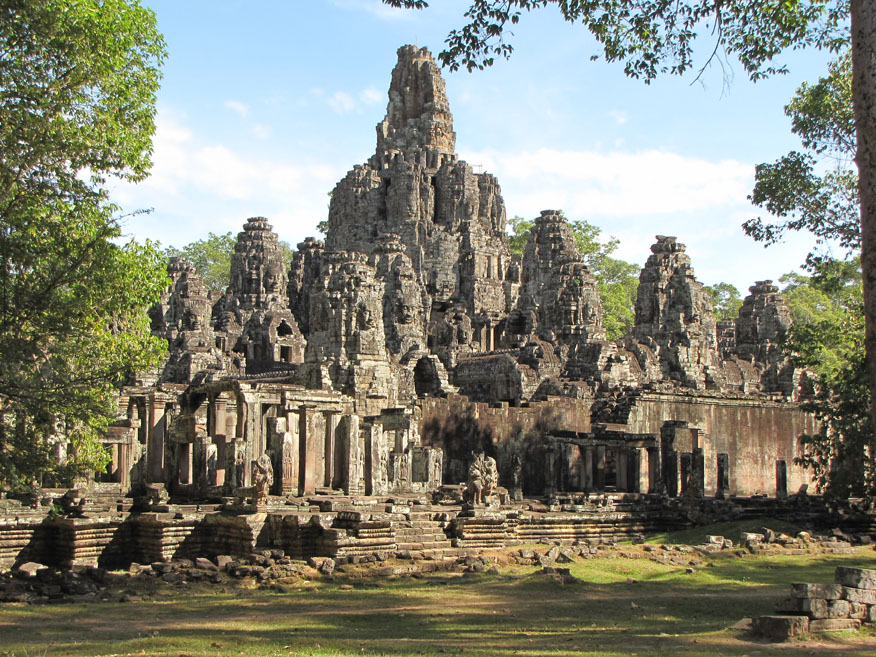
Main Temple at Bayon, Angkor Thom
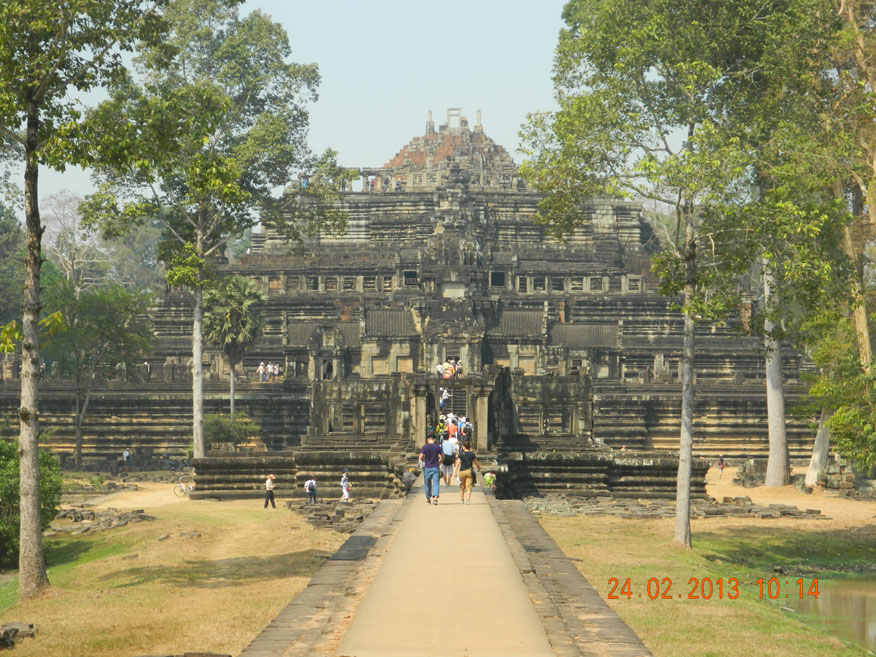
Baphuon, Angkor Thom
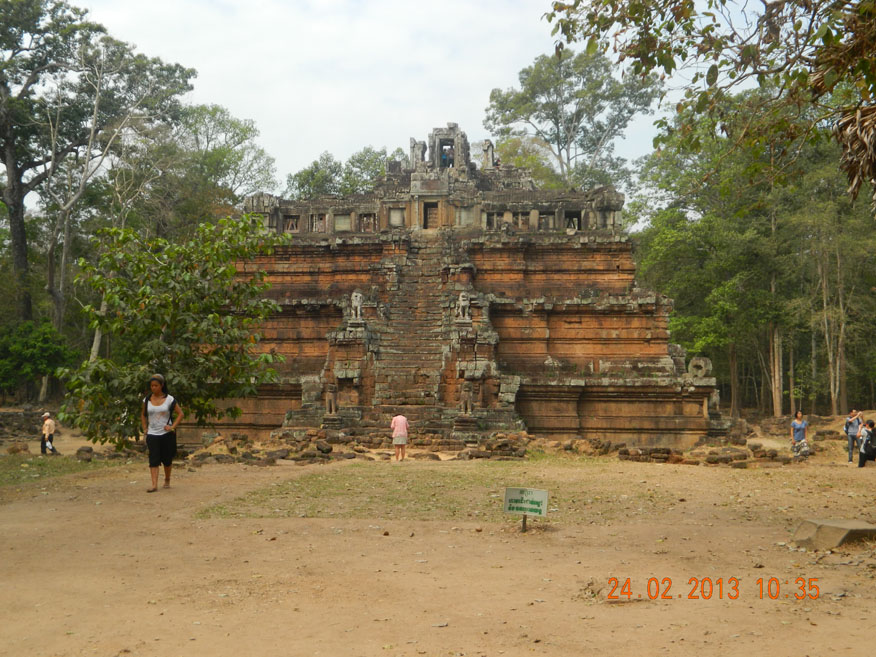
Phimeanakas, Angkor Thom
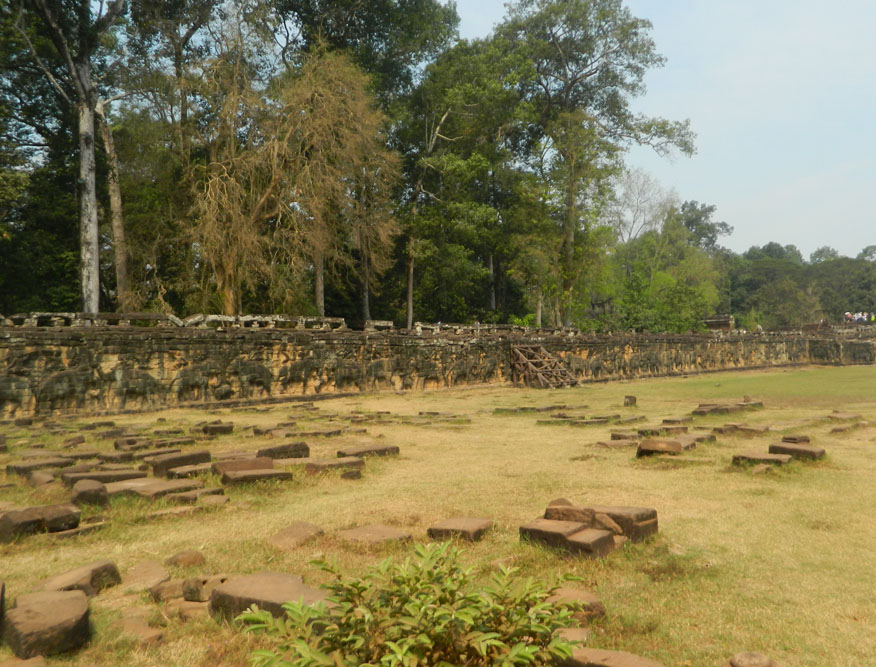
Terrace of the Elephants, Angkor Thom
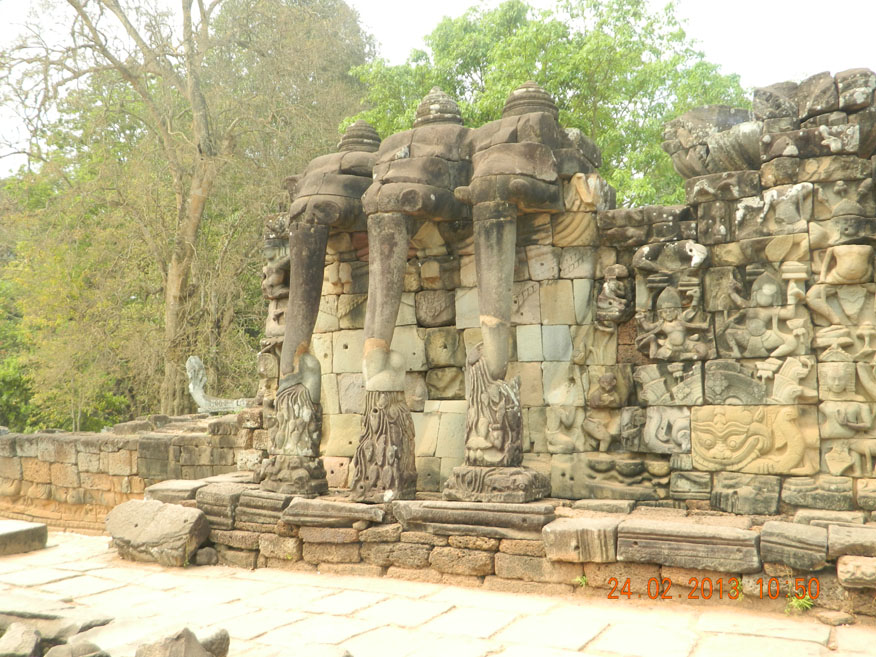
Terrace of the Leper King, Angkor Thom
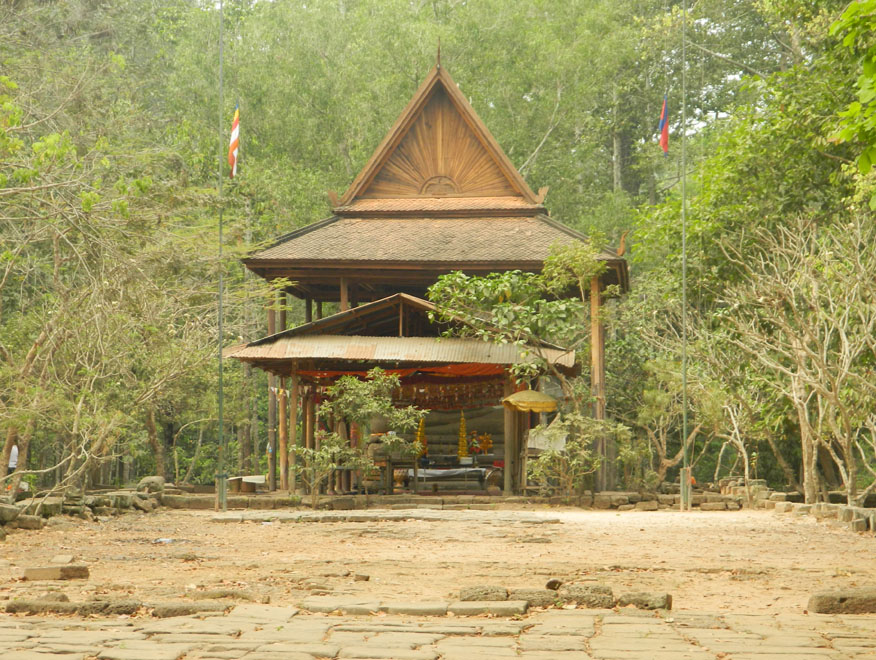
Tep Pranam, Angkor Thom
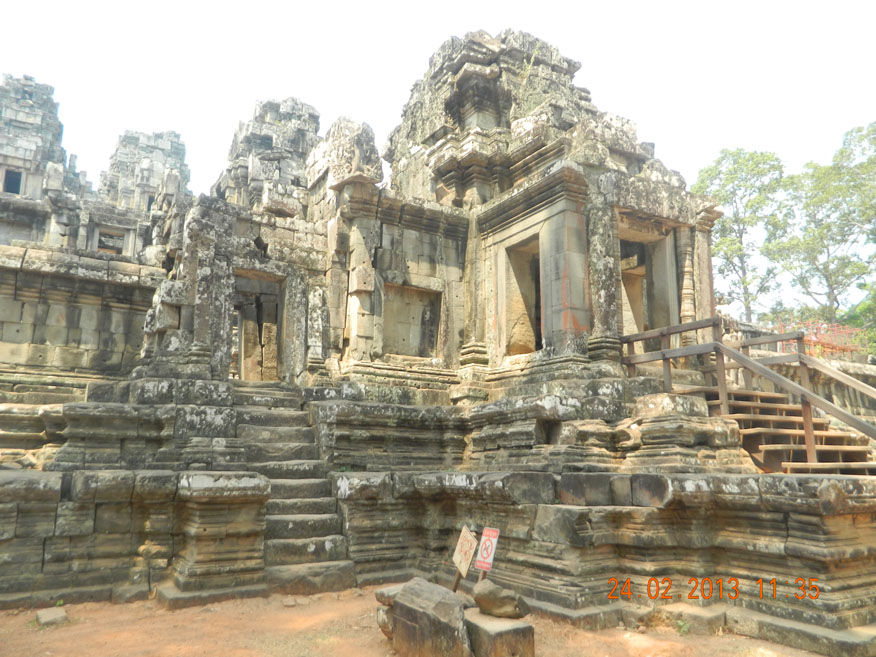
Ta Keo, Angkor Historical Park
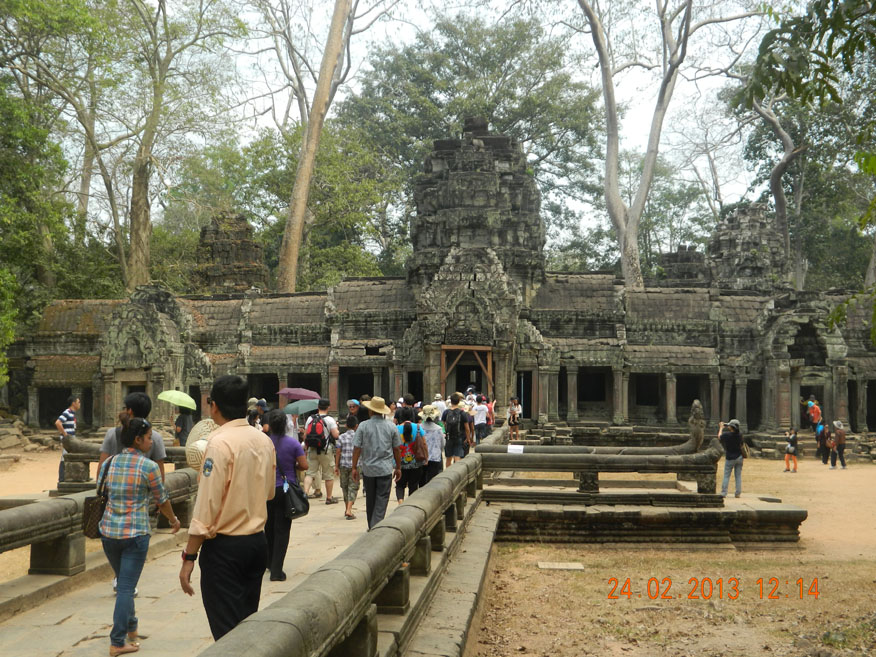
Ta Phrom, Angkor Historical Park
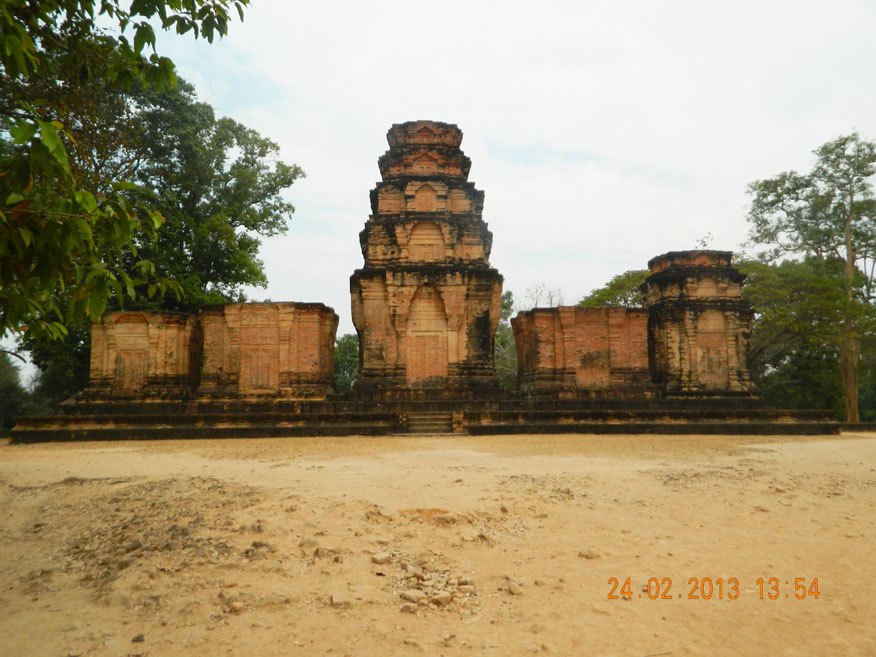
Prasat Kravan, Angkor Historical Park
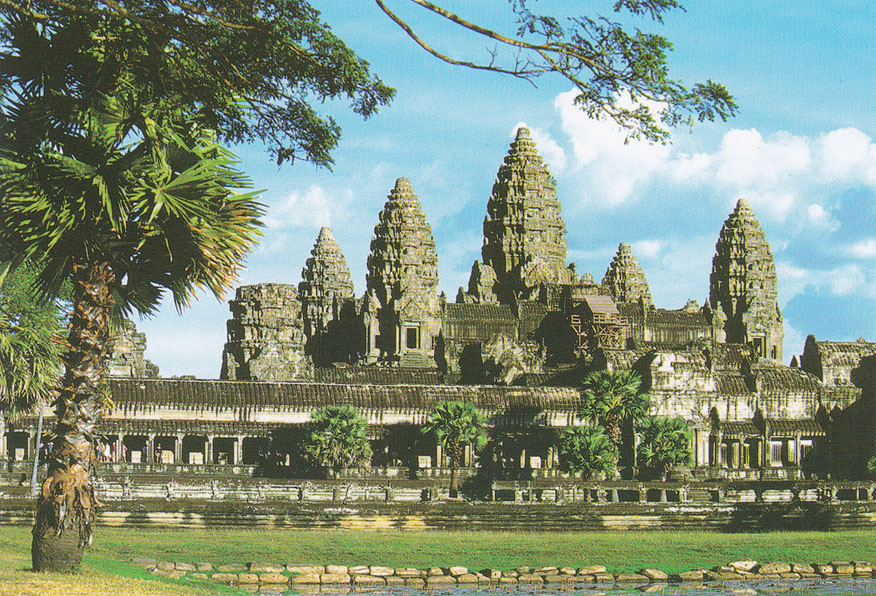
Main Temple at Angkor Wat
Siem Reap
Siem Reap Night Market